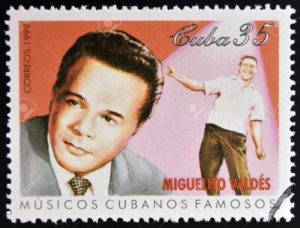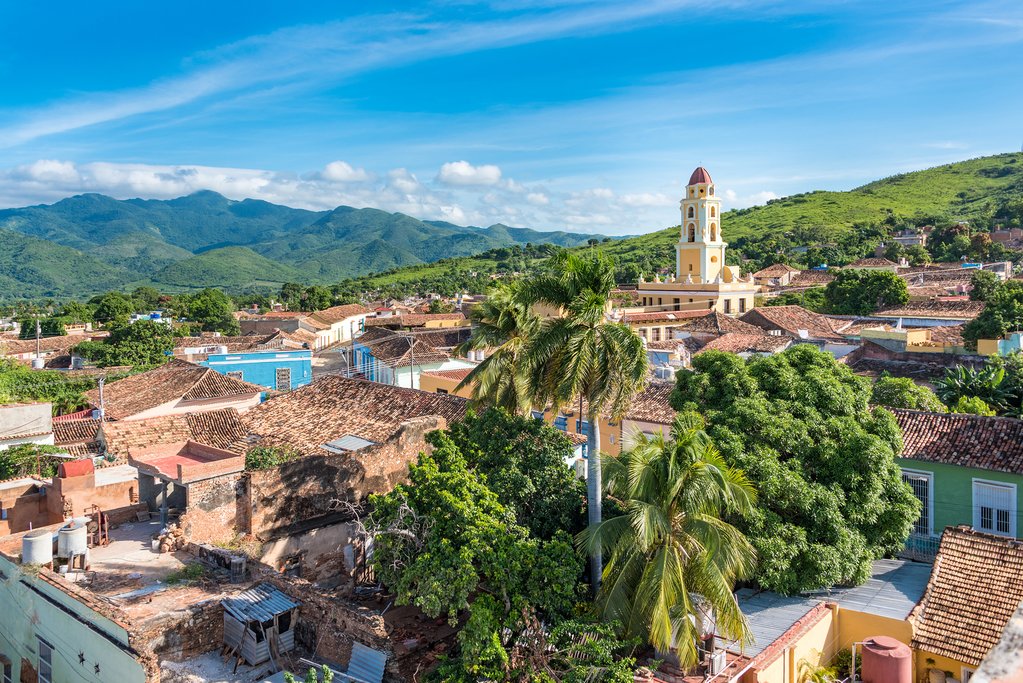MIGUELITO VALDÉS, “MR.BABALÚ”, SINGER, COMPOSER AND BANDLEADER. VIDEOS
Miguelito Valdés, also known as Mr. Babalu, was born in Belen a barrio of Old Havana, Cuba on September 6, 1912, he was a renowned Cuban singer. His performances were characterized by a strong voice and a particular sense of cubanismo.
Miguelito was born as Miguel Ángel Eugenio Lázaro Zacarías Izquierdo Valdés Hernández. His father was Spanish and his mother was Mexican from Yucatán. When his father died they all moved to another barrio, Cayo Hueso (in Centro Habana). In 1934 he won the Amateur Championship of Cuba at his weight. One of his closest friends from his days in the barrio was Chano Pozo, and in his singing style he has been called “as black a white guy as you would meet in Havana”.
ARTISTIC CAREER
He got his start in the nightclubs of Havana, and first attracted renown as a vocalist at the Havana-Riverside Casino. Valdés began his musical career in the Sexteto Habanero Infantil, where he played, variously, the guitar, tres, double bass, timbal, and sometimes sang. Soon, his capability as a singer was realized, and from that moment he was constantly in demand. After a brief spell with María Teresa Vera’s Sexteto Occidente, he was one of the founding members of the Septeto Jóvenes del Cayo in 1929. In 1933 he moved to the charanga of Ismael Díaz, and then to the Charanga Gris, directed by the pianist and composer Armando Valdés Torres, and to the Orquesta Habana, directed by Estanislao Serviá.
https://youtu.be/20yL0XDE6Ws
MIGUELITO VALDES “MR.BABALU” SINGS (VIDEOS)
In 1934, he made his first journey abroad, to Panama, and on his return joined the Orquesta Hermanos Castro, which was a leading band of the day. He was their lead singer until 1936. In 1937, he joined a group of top musicians who formed the Orquesta Casino de la Playa. In June 1937 Valdés and Casino de la Playa began recording for RCA-Victor, making their debut with Bruca maniguá, a song composed by Arsenio Rodríguez. He was now perhaps the top singer in Cuba, on the verge of international fame. In 1939, La Playa toured South America and Central America. By that time, their records were highly successful all around Latin America.
MIGUELITO VALDES LEAVES CUBA
In 1940, Valdés briefly joined the Orquesta Riverside (another of the big Cuban bands) before emigrating to New York City, which became his home base for the rest of his career. In New York City he worked for Orquesta Siboney de Alberto Iznaga, Xavier Cugat, Noro Morales, Tito Rodríguez and Machito. He directed his own orchestra for a few years and made some successful recordings with it in 1949 and 1950. He appeared with Brazilian singer Delora Bueno in her DuMont Television Network program Flight to Rhythm (March to September 1949).
In 1947, Valdés and his Orchestra played at the third Cavalcade of Jazz concert held at Wrigley Field in Los Angeles which was produced by Leon Hefflin, Sr. on September 7. Other performers were Woody Herman, The Blenders, T-Bone Walker, Slim Gaillard, The Honeydrippers, Johnny Otis and his Orchestra, Toni Harper, Sarah Vaughn, and the Three Blazers.
He appeared in a number of films such as “You Were Never Lovelier” with Fred Astaire and Rita Hayworth, and was known as “Mr. Babalú” after his performance of Margarita Lecuona’s “Babalú”. Valdés recorded this number with three top orchestras: Casino de la Playa in Havana, and Xavier Cugat and Machito in New York. He recorded with the renowned band Sonora Matancera in 1951 and 1977. Valdés was regarded as one of the greatest soneros and guaracheros of his time. Although non-African, his interpretation of Afro-Cuban lyrics was remarkable. In 1960, he organized a revue “Mr. Babalu”, which performed in Reno, Nevada, and Lake Tahoe, California. Billed were singers Loraine Barry, Marguerita Monteil, and Josie Powell.
He suffered a fatal heart attack on stage while singing at Hotel Tequendama, Bogota, Colombia on November 9, 1978.
AS COMPOSER
Apart from being a famous singer, he was a notable songwriter as well.
Numbers he composed include “Mondongo”, “Rumba rumbero”, “Loco de amor”, “Los tambores”, “Oh, mi tambó”, “Bongó”, “Dolor cobarde”.
FILMOGRAPHY
Films he appeared in include ‘Mi reino por un torero’, ‘Suspense’ (1946), ‘Panamericana’, ‘Imprudencia’, ‘Acapulqueña’ (with María Antonieta Pons), ‘Copacabana’, ‘Mientras el cuerpo aguante’, ‘Canción para recordar’ and ‘Nacido para amarte’. Also listed is ‘Bailando nace el amor’ (with Fred Astaire and Rita Hayworth) in 1942, which may be the Spanish-language version of ‘You Were Never Lovelier’.
PERSONAL LIFE
In 1936 he married Vera Eskildsen, an aristocrat from Panama City with whom he had a son, Juan Miguel Valdés Eskildsen. In 1968 he lived in Palm Springs, California.
MIGUELITO VALDÉS, “MR.BABALÚ”, CANTANTE, COMPOSITOR Y DIRIGENTE. VIDEOS
Miguelito Valdés, también conocido como el Sr. Babalu, nació en Belén un barrio de La Habana Vieja, Cuba el 6 de septiembre de 1912, fue un reconocido cantante cubano. Sus actuaciones se caracterizaron por una voz fuerte y un particular sentido del cubanismo.
Miguelito nació como Miguel Ángel Eugenio Lázaro Zacarías Izquierdo Valdés Hernández. Su padre era español y su madre era mexicana de Yucatán. Cuando murió su padre, todos se mudaron a otro barrio, Cayo Hueso (en Centro Habana). En 1934 ganó el Campeonato Amateur de Cuba con su peso. Uno de sus amigos más cercanos de sus días en el barrio fue Chano Pozo, y en su estilo de canto lo han llamado “tan negro y blanco como lo encontraría en La Habana”.
CARRERA ARTÍSTICA
Comenzó en los clubes nocturnos de La Habana, y primero atrajo renombre como vocalista en el Casino Havana-Riverside. Valdés inició su carrera musical en el Sexteto Habanero Infantil, donde tocaba, de diversas formas, la guitarra, el tres, el contrabajo, el timbal, y en ocasiones cantaba. Pronto, su capacidad como cantante se hizo realidad, y desde ese momento fue constantemente solicitado. Tras un breve paso por el Sexteto Occidente de María Teresa Vera, fue uno de los miembros fundadores del Septeto Jóvenes del Cayo en 1929. En 1933 se trasladó a la charanga de Ismael Díaz, y luego a la Charanga Gris, dirigida por el pianista y el compositor Armando Valdés Torres, ya la Orquesta Habana, dirigida por Estanislao Serviá.
https://youtu.be/sbji2mjs7cE
MIGUELITO VALDES “MR.BABALU” CANTA (VIDEOS)
En 1934 realizó su primer viaje al exterior, a Panamá, y a su regreso se incorporó a la Orquesta Hermanos Castro, que era una de las principales bandas de la época. Fue su cantante principal hasta 1936. En 1937, se unió a un grupo de músicos de primer nivel que formaron la Orquesta Casino de la Playa. En junio de 1937 Valdés y Casino de la Playa comienzan a grabar para RCA-Victor, debutando con Bruca maniguá, canción compuesta por Arsenio Rodríguez. Ahora era quizás el cantante más importante de Cuba, al borde de la fama internacional. En 1939, La Playa realizó una gira por América del Sur y América Central. En ese momento, sus discos tenían un gran éxito en toda América Latina.
MIGUELITO VALDES SALGA DE CUBA
En 1940, Valdés se unió brevemente a la Orquesta Riverside (otra de las grandes bandas cubanas) antes de emigrar a la ciudad de Nueva York, que se convirtió en su base de operaciones durante el resto de su carrera. En la ciudad de Nueva York trabajó para la Orquesta Siboney de Alberto Iznaga, Xavier Cugat, Noro Morales, Tito Rodríguez y Machito. Dirigió su propia orquesta durante algunos años e hizo algunas grabaciones exitosas con ella en 1949 y 1950. Apareció con la cantante brasileña Delora Bueno en su programa de DuMont Television Network Flight to Rhythm (marzo a septiembre de 1949).
En 1947, Valdés y su orquesta tocaron en el tercer concierto de Cavalcade of Jazz celebrado en Wrigley Field en Los Ángeles que fue producido por Leon Hefflin, Sr. el 7 de septiembre. Otros artistas fueron Woody Herman, The Blenders, T-Bone Walker, Slim Gaillard, The Honeydrippers, Johnny Otis y su orquesta, Toni Harper, Sarah Vaughn y los Three Blazers.
https://youtu.be/O06dZK1GOOw
MIGUELITO VALDES “MR. BABALU” CANTA (VIDEOS)
Apareció en varias películas como “Nunca fuiste más encantador” con Fred Astaire y Rita Hayworth, y fue conocido como “Mr. Babalú” por su interpretación de “Babalú” de Margarita Lecuona. Valdés registró este número con tres orquestas de primer nivel: Casino de la Playa en La Habana y Xavier Cugat y Machito en Nueva York. Grabó con la reconocida banda Sonora Matancera en 1951 y 1977. Valdés fue considerado como uno de los más grandes soneros y guaracheros de su tiempo. Aunque no africano, su interpretación de las letras afrocubanas fue notable. En 1960, organizó una revista “Mr. Babalu”, que actuó en Reno, Nevada y Lake Tahoe, California. Se facturaron las cantantes Loraine Barry, Marguerita Monteil y Josie Powell.
Sufrió un infarto fatal en el escenario mientras cantaba en el Hotel Tequendama, Bogotá, Colombia el 9 de noviembre de 1978.
COMO COMPOSITOR
Además de ser un cantante famoso, también fue un compositor notable.
Los temas que compuso incluyen “Mondongo”, “Rumba rumbero”, “Loco de amor”, “Los tambores”, “Oh, mi tambó”, “Bongó”, “Dolor cobarde”.
FILMOGRAFÍA
Películas en las que apareció incluyen ‘Mi reino por un torero’, ‘Suspense’ (1946), ‘Panamericana’, ‘Imprudencia’, ‘Acapulqueña’ (con María Antonieta Pons), ‘Copacabana’, ‘Mientras el cuerpo aguante’, ‘ Canción para recordar ‘y’ Nacido para amarte ‘. También aparece ‘Bailando nace el amor’ (con Fred Astaire y Rita Hayworth) en 1942, que puede ser la versión en español de ‘You Were Never Lovelier’.
VIDA PERSONAL
En 1936 se casó con Vera Eskildsen, una aristócrata de la ciudad de Panamá con quien tuvo un hijo, Juan Miguel Valdés Eskildsen. En 1968 vivió en Palm Springs, California.
Agencies/ Wiki/ Various/ Internet Photos/ YouTube/ Arnoldo Varona/ www.TheCubanHistory.com
THE CUBAN HISTORY, HOLLYWOOD.










